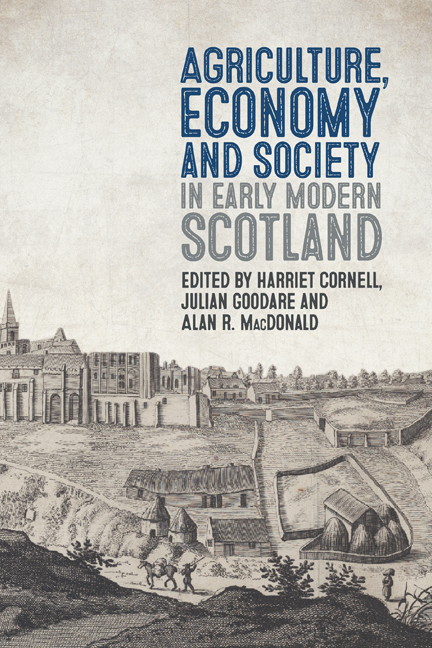265 results
A.1 Repurposing Ambroxol as a disease-modifying treatment for Parkinson’s disease dementia: A phase 2, randomized, double blind placebo-controlled trial
-
- Journal:
- Canadian Journal of Neurological Sciences / Volume 51 / Issue s1 / June 2024
- Published online by Cambridge University Press:
- 24 May 2024, p. S3
-
- Article
-
- You have access
- Export citation

Agriculture, Economy and Society in Early Modern Scotland
-
- Published by:
- Boydell & Brewer
- Published online:
- 14 May 2024
- Print publication:
- 23 April 2024
Contributors
-
- Book:
- Agriculture, Economy and Society in Early Modern Scotland
- Published by:
- Boydell & Brewer
- Published online:
- 14 May 2024
- Print publication:
- 23 April 2024, pp xi-xii
-
- Chapter
- Export citation
Map of Scotland
-
- Book:
- Agriculture, Economy and Society in Early Modern Scotland
- Published by:
- Boydell & Brewer
- Published online:
- 14 May 2024
- Print publication:
- 23 April 2024, pp xvi-xvi
-
- Chapter
- Export citation
Boydell Studies in Rural History
-
- Book:
- Agriculture, Economy and Society in Early Modern Scotland
- Published by:
- Boydell & Brewer
- Published online:
- 14 May 2024
- Print publication:
- 23 April 2024, pp 291-291
-
- Chapter
- Export citation
Acknowledgements
-
- Book:
- Agriculture, Economy and Society in Early Modern Scotland
- Published by:
- Boydell & Brewer
- Published online:
- 14 May 2024
- Print publication:
- 23 April 2024, pp xiii-xiii
-
- Chapter
- Export citation
6 - The Roots of Improvement: Early Seventeenth-Century Agriculture on the Mains of Dundas, Linlithgowshire
-
-
- Book:
- Agriculture, Economy and Society in Early Modern Scotland
- Published by:
- Boydell & Brewer
- Published online:
- 14 May 2024
- Print publication:
- 23 April 2024, pp 147-163
-
- Chapter
- Export citation
Illustrations
-
- Book:
- Agriculture, Economy and Society in Early Modern Scotland
- Published by:
- Boydell & Brewer
- Published online:
- 14 May 2024
- Print publication:
- 23 April 2024, pp ix-x
-
- Chapter
- Export citation
Contents
-
- Book:
- Agriculture, Economy and Society in Early Modern Scotland
- Published by:
- Boydell & Brewer
- Published online:
- 14 May 2024
- Print publication:
- 23 April 2024, pp vii-viii
-
- Chapter
- Export citation
Note on Currency and Measures
-
- Book:
- Agriculture, Economy and Society in Early Modern Scotland
- Published by:
- Boydell & Brewer
- Published online:
- 14 May 2024
- Print publication:
- 23 April 2024, pp xiv-xiv
-
- Chapter
- Export citation
Abbreviations
-
- Book:
- Agriculture, Economy and Society in Early Modern Scotland
- Published by:
- Boydell & Brewer
- Published online:
- 14 May 2024
- Print publication:
- 23 April 2024, pp xv-xv
-
- Chapter
- Export citation
Frontmatter
-
- Book:
- Agriculture, Economy and Society in Early Modern Scotland
- Published by:
- Boydell & Brewer
- Published online:
- 14 May 2024
- Print publication:
- 23 April 2024, pp i-iv
-
- Chapter
- Export citation
Introduction: Exploring Scotland’s Agricultural History
-
-
- Book:
- Agriculture, Economy and Society in Early Modern Scotland
- Published by:
- Boydell & Brewer
- Published online:
- 14 May 2024
- Print publication:
- 23 April 2024, pp 1-23
-
- Chapter
- Export citation
Index
-
- Book:
- Agriculture, Economy and Society in Early Modern Scotland
- Published by:
- Boydell & Brewer
- Published online:
- 14 May 2024
- Print publication:
- 23 April 2024, pp 275-290
-
- Chapter
- Export citation
Dedication
-
- Book:
- Agriculture, Economy and Society in Early Modern Scotland
- Published by:
- Boydell & Brewer
- Published online:
- 14 May 2024
- Print publication:
- 23 April 2024, pp v-vi
-
- Chapter
- Export citation
Plastic Pulse of the Public: A review of survey-based research on how people use plastic – ADDENDUM
-
- Journal:
- Cambridge Prisms: Plastics / Volume 1 / 2023
- Published online by Cambridge University Press:
- 07 August 2023, e13
-
- Article
-
- You have access
- Open access
- HTML
- Export citation
The effect of music to improve sleep quality in depression related insomnia
-
- Journal:
- European Psychiatry / Volume 66 / Issue S1 / March 2023
- Published online by Cambridge University Press:
- 19 July 2023, p. S220
-
- Article
-
- You have access
- Open access
- Export citation
Plastic Pulse of the Public: A review of survey-based research on how people use plastic
-
- Journal:
- Cambridge Prisms: Plastics / Volume 1 / 2023
- Published online by Cambridge University Press:
- 19 June 2023, e8
-
- Article
-
- You have access
- Open access
- HTML
- Export citation
The effect of transport stress on neutrophil activation in wild badgers (Meles meles)
-
- Journal:
- Animal Welfare / Volume 13 / Issue 3 / August 2004
- Published online by Cambridge University Press:
- 11 January 2023, pp. 355-359
-
- Article
- Export citation
Body weight change as a measure of stress: a practical test
-
- Journal:
- Animal Welfare / Volume 13 / Issue 3 / August 2004
- Published online by Cambridge University Press:
- 11 January 2023, pp. 337-341
-
- Article
- Export citation



